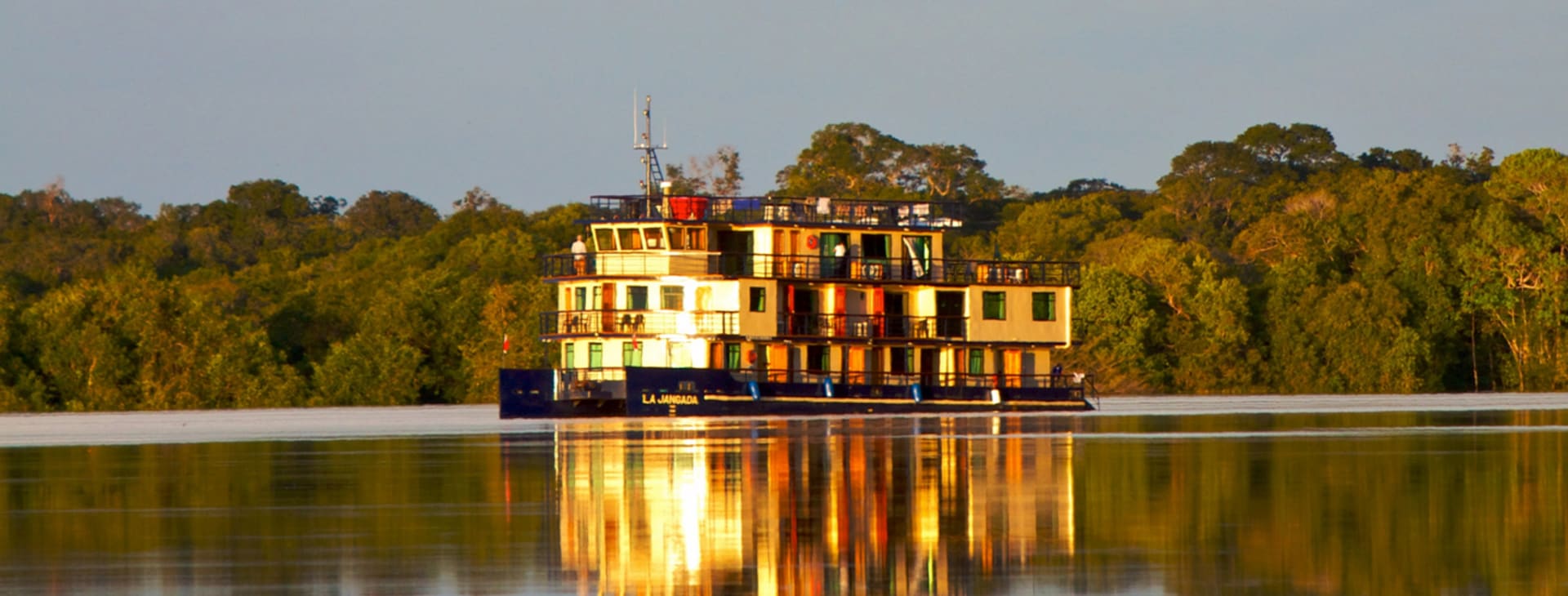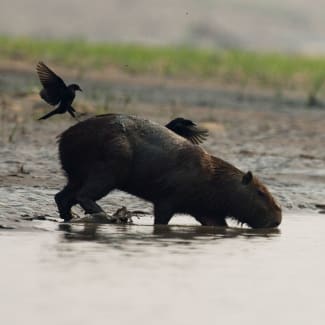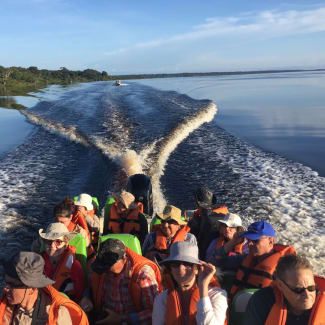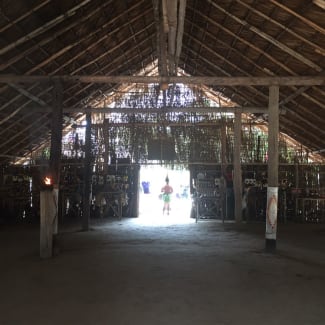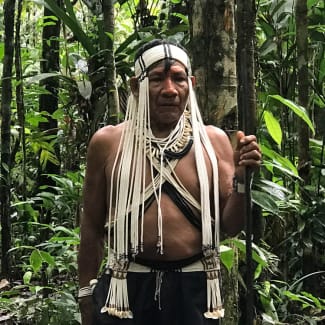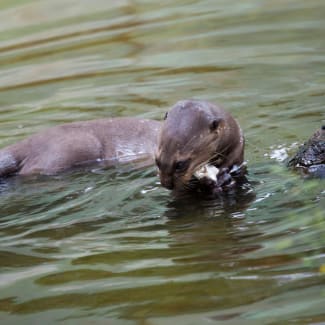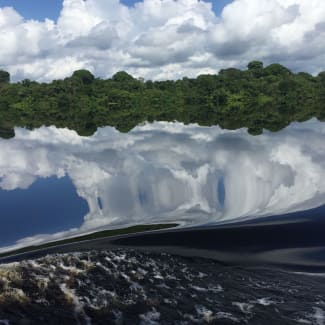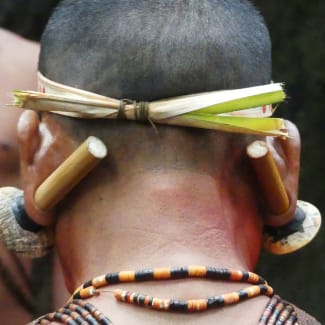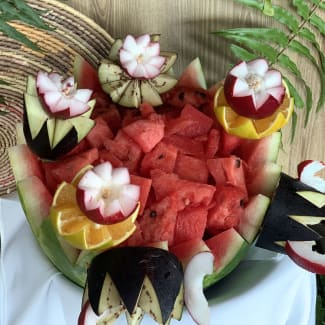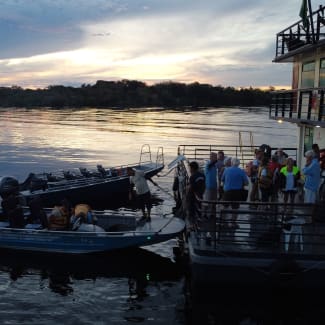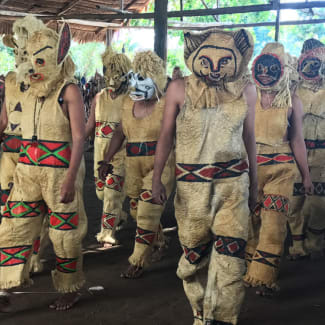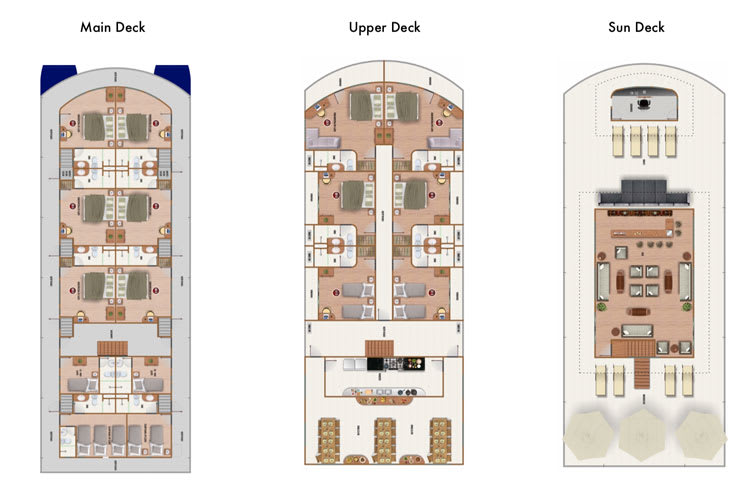Overview
Launched in 2019, La Jangada is one of the newest ships in the Amazon and the only luxury catamaran in the region. This 12-cabin ship welcomes up to 29 guests for chartered trips ranging from 4 – 8 days. No matter the itinerary selected, the focus is always on providing remarkable comfort, quality service, and specialized activities.
Life Aboard The La Jangada Cruise Ship
While on a La Jangada cruise, it is possible to feel perfectly comfortable and pampered in the wilds of the Amazon. A total of 13 crew members will help turn your stay into a lifetime of memories. The ship’s interiors are decorated with contemporary art and indigenous artifacts to blend modern style with the attitude and history of the Amazon. The 95-foot steel catamaran features a large dining area on the upper deck.
A Brazilian chef serves local favorites, such as feijoada – a stew of beans with beef or pork, or bolinho de piracui – fried balls of fish accompanied by dipping sauces. At the top of the ship, several social and public areas make up the ship’s heart. A large lounge bar serves everything from fresh-squeezed juices to Brazilian cocktails and offers soft, comfortable seating out of the sun. Head out to the observation deck to recline in comfortable lounge chairs to watch for wildlife on the riverbanks or gaze at the stars.
Excursions From Your La Jangada Amazon Cruise
While life aboard the La Jangada is all about relaxing in an upscale environment, the activities and excursions are opportunities to get close to nature and delve into Amazonian communities.
Along the way, you will fish for giant catfish in the Purus River in hopes of adding something extra to the night’s meal. Rides in two aluminum low-emission speed boats allow you to search for pink dolphins, caimans, otters, and jaguars. You will also visit the village of Bethania, where you will learn about traditional rituals and watch an initiation ceremony to welcome young women in the community.
Itineraries & Prices
All itineraries are subject to change due to seasonal weather conditions (and resultant variations in river and tributary water levels) affecting accessibility to locations. Thus navigation routes, times and excursions may need to be modified at the cruise captain’s or your guide's discretion.
Embarkation
AM: Embarking at 9:00, we welcome you aboard La Jangada, and give you an introductory briefing about the itinerary and the background to some of the incredible things you will witness.Our first excursion is in our expedition canoes at Lago Janauary, a rich ecosystem fed by the waters of the Rio Solimões, which is abundant in organic nutrients, and therefore supports an abundance of Amazon birds, reptiles, exotic plants, and giant trees. You are likely to see Tucuxi River Dolphins, Pink River Dolphin, Cocoi Heron, Great Egret, Blue-Yellow Macaw, Festive Parrot, Rufescent Tiger-herons, Yellow-rumped Caciques, Crested Oropendola, and Jacamars, among many others.
PM: Once back on board, we sail along the Paraná do Paracuuba to the Rio Solimões, enjoying our first lunch on board as we do so. In the afternoon, we arrive at the famous Meeting of the Waters, where the black Rio Negro meets the clearer water of the Solimões and they run parallel for more than nine miles. Then it’s time to search for pirarucu, the largest-scaled fish in the world, nicknamed the Lion of the Amazon. While we have dinner on board, the boat sails up the Rio Negro towards the Anavilhanas Archipelago.

Rio Negro, Rio Ariaú & Acajatuba Lake
AM: At daybreak, we can watch the sunrise over the Tupé Beach settlement, beside the high Rio Negro. After breakfast on board, we visit the village where we will have the opportunity to witness their well-preserved history, customs, dance, and handicrafts. The villagers communicate in two indigenous languages, Tuiuka and Tukano.
PM: Once back on board La Jangada, we have lunch and then sail to the Rio Ariaú, a beautiful blackwater river enclosed by giant trees and dense vegetation. Here we have the option of climbing one of the trees - or at least, some of it - using ropes. We continue to Lago Acajatuba to see the iconic pink Amazon river dolphin up close, in an area where the locals live in the floating houses region. After dinner on board, we set out in our expedition canoes to search for caiman and other nocturnal animals.

Anavilhanas Archipelago
AM: Upon waking up, we are in the heart of the Anavilhanas River Archipelago - 100,000 hectares of islands and canals within the Rio Negro and a further 260,000 hectares of riverside forest. So, after breakfast, we take to the canoes to explore this stunning region of creeks, lagoons, and river beaches. Under the shadow of a Macacarecuia tree, we swim with inflatable tubes in the refreshing waters of the Rio Negro. Later we'll try our hand at fishing for piranha in the Igarapé of Jaraqui. How many can you catch?
PM: After lunch on board, we visit an Amazon farmhouse in the Santo Antonio community, where the owner will explain his way of life, his ancestry, and the crops he raises, such as manioc and fruit. We then make a 2-hour guided trek through the rainforest, to spot and learn about the flora and fauna. Finally, this evening, we set sail through the heart of Anavilhanas National Park and after dinner embark on a night-time aquatic trail full of wildlife.

Disembarkation
AM: The day starts with the sound of the jungle - and especially its birdlife and primates - waking up. After breakfast onboard we will spend the morning on another aquatic trail looking out for the wildlife, especially monkeys, along our way through the archipelago. We return to civilization and a city tour of Novo Airão, famous for its crafts, artisan workshops, shipyards, and pink river dolphins.
PM: After a farewell lunch at the 'Flor do Luar', a floating restaurant in the national park we are transferred by road back to Manaus, arriving mid-afternoon.

Embarkation
AM: At around 09:00, we will be transferred by air-conditioned van to Novo Airão where the Jacaré-Açu awaits us. Following a quick explanation of the region and what we might encounter over the next few days, we'll begin sailing to the Anavilhanas Archipelago.
PM: After lunch on board we'll begin to explore some of the aquatic trails of the igapós and lakes in this incredible archipelago. Keep your eyes peeled for pink dolphins and a whole variety of birds such as Maguaris, Herons, Blue and Red Macaws, Parrots, Japiins and Japós. We may even be lucky enough to spot a Giant Otter! After a fun afternoon swimming with lifebuoys on the Rio Negro, a nutritious dinner will be served on board. Overnight the boat will continue navigating until we reach the Igarapé Içana.

Apuaú Wild Waterfalls
AM: This morning we wake up on the Apuaú River. After breakfast, we'll sail by motorboat on the Igarapé Içana streams until we reach its main waterfall where we can indulge in many aquatic activities, diving in the river or relaxing in the natural pools.
PM: A traditional ‘Caboclo’ Lunch of grilled fish and side dishes will be served, followed by a siesta in our hammocks, before our afternoon hike through virgin forest, to the waterfall of ‘Igarapé do Trovão’, another stream of the Apuaú River. Here we'll find our camp for the night, surrounded by two natural pools. Dinner will be served around the campfire, as our guides tell us tales of the local caboclo folklore. Overnight jungle stays in tents or hammocks are available.
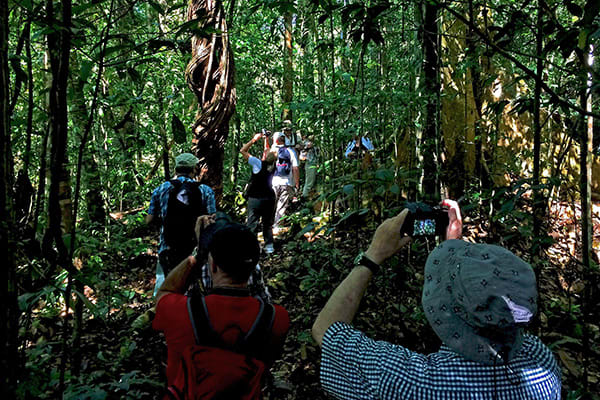
Waterfall Circuit
AM: We wake up to the sounds of the forest, an incredible experience. Breakfast is followed by more leisure time at the waterfall and its pools. On our way back, we have two options: return to the main boat by motorboat on the ‘Igarapé do Trovão’ stream, or return on foot, followed by rafting on the considerable current of the ‘Igarapé Içana’.
PM: As we return to the boat and the Rio Negro, we lunch on board. This is followed by relaxation time in the comfort of the boat.

Disembarkation
AM: We wake up once again on the Rio Negro surrounded by nature. After breakfast, we pay a visit to a giant Samauma tree, the largest in the Amazon. Returning to the boat, we start navigation towards Novo Airão. Here we enjoy the magical experience of interacting with pink dolphins and take a brief city tour to see the handicrafts, craft workshops, and city attractions.
PM: After a farewell lunch on the boat we are transferred from Novo Airão to Manaus, arriving mid-afternoon.

Embarkation
AM: At 9:00 we pick you up from your hotel or the airport in an air-conditioned van, and drive to the riverside town of Novo Airão. We arrive here in the early afternoon and give you a briefing on Amazon's biology, history, and the things you may see, along the way. After boarding the Jacaré-Açu, we start sailing through the spectacular Anavilhanas Archipelago while enjoying our first delicious lunch on board.
PM: In the afternoon, we take a ride on the motorized canoes through the islands and lagoons of the archipelago. This is an area rich in wildlife, and we hope to see two species of river dolphin, as well as multiple species of birds, such as herons, egrets, macaws, parrots, caciques, oropendolas, and jacamars. Once back on the boat, we set sail to Madadá Observatory, a spectacular lookout over the Rio Negro, with basic bungalow facilities in the middle of the jungle. After dinner on board, you can choose if you want to spend the night in your cabin or a hammock at the Observatory.

Anavilhanas & Madadá Caves
AM: After breakfast, we make a three-hour round-trip hike through virgin rainforest to Madadá Caves, with our guides giving a mini jungle survival course, along the way. We then visit an Amazon farmhouse to learn about local customs, farming techniques, and crops. In the late morning, we have a chance to cool off with a dip in the Rio Negro.
PM: After lunch on board, we set sail for the Rio Negro State Park area and a chance to try our hand at piranha fishing before sunset. Once back on the boat we set sail to Sleepy Beach, on the Rio Jau, where we will anchor for the night and enjoy dinner and sit around a bonfire for a night of native folklore storytelling.

Jaú National Park
AM: This morning we sail to the Jaú National Park Ranger Station, and then along the Rio Jaú, a river of mirror-like waters, with likely sightings of aquatic mammals and birds. The Park consists of three major rivers - Unini to the North, Carabinani to the South, and Jau in the middle - along with countless smaller black water tributaries.
The water level varies drastically during the year and the igapó forest found near the waterways can be flooded for up to eight months of the year. This type of forest is tropical and humid, with as many as 200 species per hectare. In the rainy season, we moor the boat and take the canoes through the Park’s creeks, looking for families of Giant Otters. In the dry season, we explore the Rio Pauini, a tributary filled with boulders and waterfalls.
PM: On return to the Jacaré-Açu, we sail to the indigenous community of Aturia where we moor for the evening. After dark, we go looking for caiman and nocturnal animals in the canoes, using spotlights.

Jaú National Park
AM: This morning, after breakfast, we visit Cachoeira community, where we can learn more about traditional life in the Amazon. The children of the village are always extremely happy to interact with visitors, so be prepared to get involved in a game of soccer or swimming or some impromptu arts and crafts.
Later we will be visiting a giant tree around the community, a very old lady from the ancient forest, before we begin an aquatic trail with regional canoes, keeping a lookout for Bicoh Monkeys and other animals.
PM: Once back on the boat, we have lunch on board before we return to the IBAMA base and sail out of Jaú National Park.

Disembarkation
AM: Today we continue sailing from Jaú to Novo Airão. On the way, we may have the chance to swim with Pink River Dolphins. A real highlight. Once back in Novo Airão, we take a city tour to see the ship-building, the craftsmanship, and other attractions of this Amazon River town.
PM: We have a farewell lunch on “Flor do Luar”, a floating restaurant in the Anavilhanas National Park. before taking the van back to Manaus, arriving mid-afternoon.

Embarkation
AM: Embarking at 9:00, we welcome you aboard the Jacaré-Açu, and give you an introductory briefing about the itinerary and the background to some of the incredible things you will witness.
Our first excursion is in our expedition canoes at Lago Janauary, a rich ecosystem fed by the waters of the Rio Solimões, which is abundant in organic nutrients, and therefore supports an abundance of Amazon birds, reptiles, exotic plants, and giant trees. You are likely to see Tucuxi River Dolphins, Pink River Dolphin, Cocoi Heron, Great Egret, Blue-Yellow Macaw, Festive Parrot, Rufescent Tiger-herons, Yellow-rumped Caciques, Crested Oropendola, and Jacamars, among many others.
PM: Once back on board, we sail along the Paraná do Paracuuba to the Rio Solimões, enjoying our first lunch on board as we do so. In the afternoon, we arrive at the famous Meeting of the Waters, where the black Rio Negro meets the clearer water of the Solimões and they run parallel for more than nine miles. Then it’s time to search for pirarucu, the largest scaled fish in the world, nicknamed the Lion of the Amazon. While we have dinner on board, the boat sails up the Rio Negro towards the Anavilhanas Archipelago.
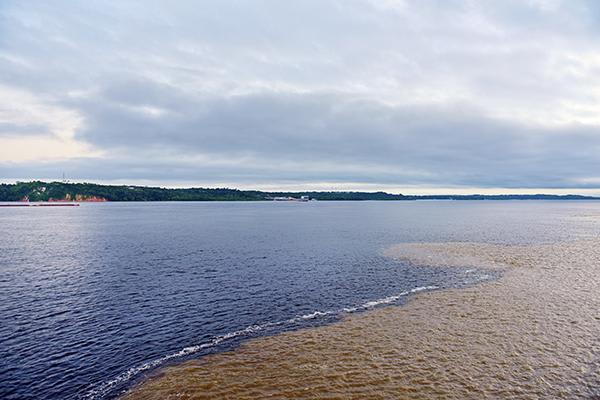
Rio Negro, Rio Ariaú & Acajatuba Lake
AM: At daybreak, we can watch the sunrise over the Tupé Beach settlement, beside the high Rio Negro. After breakfast on board, we visit the village where we will have the opportunity to witness their well-preserved history, customs, dance, and handicrafts. The villagers communicate in two indigenous languages, Tuiuka and Tukano.
PM: Once back on board the Jacaré-Açu, we have lunch and then sail to the Rio Ariaú, a beautiful blackwater river enclosed by giant trees and dense vegetation. Here we have the option of climbing one of the trees - or at least, some of it - using ropes. We continue to Lago Acajatuba to see the iconic pink Amazon river dolphin up close, in an area where the locals live in floating houses region. After dinner on board, we set out in our expedition canoes to search for caiman and other nocturnal animals.

Anavilhanas Archipelago
AM: Upon waking up, we are in the heart of the Anavilhanas River Archipelago - 100,000 hectares of islands and canals within the Rio Negro and a further 260,000 hectares of the riverside forest. So, after breakfast, we take to the canoes to explore this stunning region of creeks, lagoons, and river beaches.
PM: After lunch, we visit an Amazon farmhouse, where the owner will explain his way of life, his ancestry, and the crops he raises, such as manioc and fruit. We then make a 2-hour guided trek through the rainforest, to spot and learn about the flora and fauna.
Finally, this evening, we have the option of staying overnight in a hammock at an atmospheric jungle hut camp. Around the campfire, we can share stories and learn about the way of life of the Amazon's settlers.

Anavilhanas & Madadá Caves
AM: After breakfast, we make a three-hour round-trip hike through virgin rainforest to Madadá Caves, with our guides giving a mini jungle survival course, along the way. We then visit an Amazon farmhouse to learn about local customs, farming techniques, and crops. In the late morning, we have another chance to cool off with a dip in the Rio Negro.
PM: After lunch on board, we take the canoes to an indigenous riverside community, where the locals speak Yanomami and Tukano and have fascinating centuries-old customs. Once back on the boat we set sail to Sleepy Beach, on the Rio Jau, where we will anchor for the night.
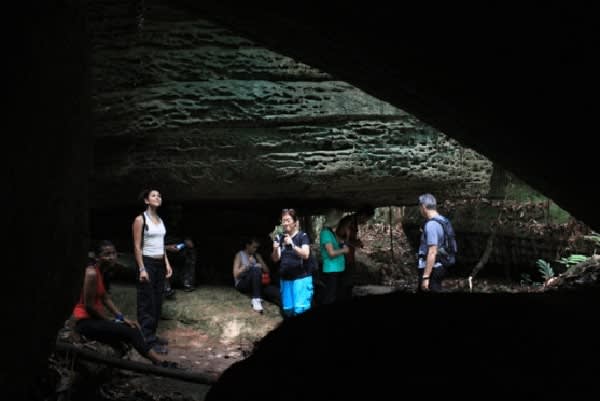
Jaú National Park
AM: This morning we sail to the Jaú National Park Ranger Station, and then along the Rio Jaú, a river of mirror-like waters, with likely sightings of aquatic mammals and birds. The Park consists of three major rivers - Unini to the North, Carabinani to the South, and Jau in the middle - along with countless smaller black water tributaries. The water level varies drastically during the course of the year and the igapó forest found near the waterways can be flooded for up to eight months of the year. This type of forest is tropical and humid, with as many as 200 species per hectare.
In the rainy season, we moor the boat and take the canoes through the Park’s creeks, looking for families of Giant Otters. In the dry season, we explore the Rio Pauini, a tributary filled with boulders and waterfalls.
PM: On return to the Jacaré-Açu, we sail to the indigenous community of Aturia where we moor for the evening. After dark, we go looking for caiman and nocturnal animals in the canoes, using spotlights.
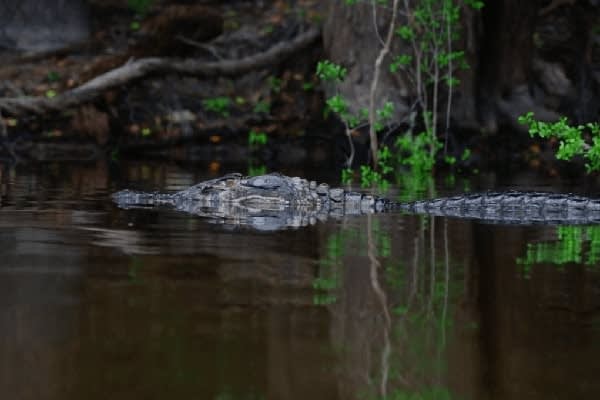
Jaú National Park
AM: This morning, after breakfast, we visit Aturia village, where we can learn more about traditional life in the Amazon. The children of the village are always extremely happy to interact with visitors, so be prepared to get involved in a game of soccer or swimming or some impromptu arts and crafts.
Later we will be visiting a giant tree around the community, a very old lady from the ancient forest, before we begin an aquatic trail with regional canoes, keeping a lookout for Bicoh Monkeys and other animals.
PM: Once back on the boat, we have lunch on board before we return to the IBAMA base and sail out of Jaú National Park.
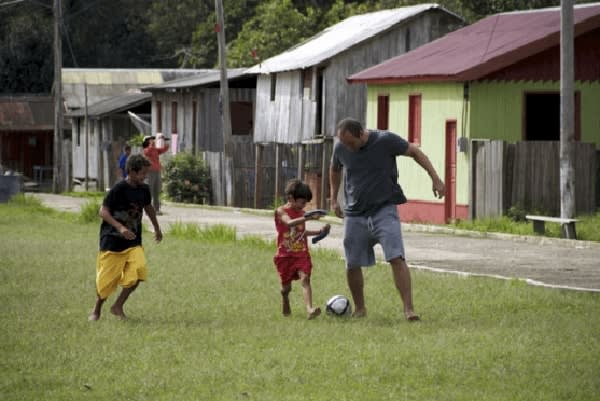
Disembarkation
AM: Today we enjoy an aquatic trail before returning to Novo Airão. Once back in Novo Airão, we take a city tour to see the ship-building, the craftsmanship, and other attractions of this Amazon River town.
PM: We have a farewell lunch on “Flor do Luar”, a floating restaurant at Anavilhanas National Park., before a relaxing swim on the Rio Negro. We'll then take the van back to Manaus, arriving mid-afternoon.

Embarkation
PM: This afternoon we pick you up from your hotel or the airport in an air-conditioned van and drive to the riverside town of Novo Airão. Lecture on Amazon's biology, history, and the things you may see, along the way. After boarding the Jacaré Açu, we start sailing while enjoying our first delicious evening meal on board. Following dinner, we begin sailing overnight to Meduini Reserve, a sanctuary adjacent to the Jaú National Park.

Wildlife Spotting & Piranha fishing
AM: This morning we sail the water trail in a canoe by Igarapé do Meduini, with a probable view of birds, porpoises, alligators, and monkeys. There is the option to take part in Piranha fishing at the end of the water safari. Or why not try your skills with a Stand-up Paddle Ride! Afterward, we begin navigation to the entrance to the Jaú National Park. We check-in at the park entrance base. Here you will get to marvel at the Samauma, the giant tree of the Amazon forest.
PM: In the afternoon we have lunch on board. Followed by the entrance to the river Carabinani or Igarapé Preto to visit and enjoy the waterfalls. Night sailing, with dinner, served on board.

Community Visit, Jungle Walk & Night Excursion
AM: The day dawns in the community of the traditional people of Cachoeira do Jaú. Take a tour via canoe of fisherman until the Island of the Apes, with the observation of the Monkey Bicó and other animals. Upon return, you will receive a tour by the local community. Afterward, visit Arvores Gigantes da região (Tanimbuca & Samaúma).
PM: Lunch on board, while the boat sails to the region of Seringalzinho. We stop for trekking in the primary forest, up to the Itaúbal waterfall. Here there is an interpretive trail of fauna and flora. We focus on finding alligators and other nocturnal animals before dinner back on board.
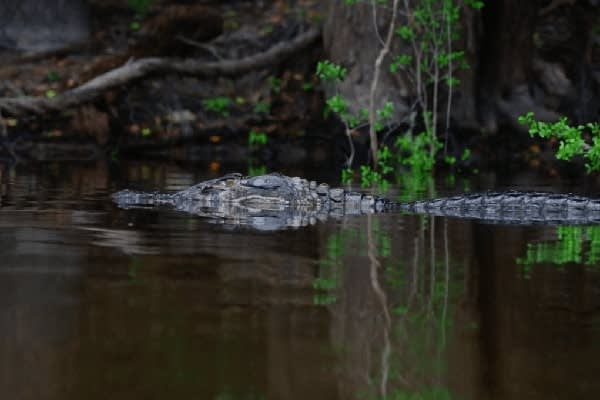
Airão Velho & Praia do Sono
AM: Our first excursion is a rapid canoe ride through inland lakes, to the base of the ICMBio at the exit of the park. We take a visit to Petroglyphs dated 800 bc (dry season). Afterward, visit the ruins of Airão Velho, an anthropological site, the first Portuguese settlement of Rio Negro.
PM: In the afternoon we take a visit to the wild waterfall of São Domingos, with a delicious lunch served here. Following, feel free to bathe and leisure at Praia do Sono. We visit the indigenous community of Mirituba, and the Sitio caboclo and Trilha Mata with a waterfall on the Puduari river (dry season). Later we enjoy dinner on board.

Museum of Madadá & Trek to Madadá Caves
AM: This morning we take a visit to the caboclo site and Madada Museum. Trekking in the primary forest to the caves of Madada is a highlight of this day, with probable animal spotting throughout.
PM: We enjoy lunch at the site. Fishing in the Juvencio igarapé is on offer this afternoon. Followed by an onboard rest at the end of the afternoon at Mirante do Madada.

Anavilhanas Archipelago & Paraná das Araras
AM: Early breakfast. Excursion of the Archipelago of Anavilhanas – Paraná do Piçá & adjacent lakes. Leisure at Praia do Camaleão (dry season). Lunch on the Beach – caboclo-style fish barbecue (season from drought).
PM: Afternoon canoe trip through Paraná das Araras. After dinner on board, evening excursion Caiman spotting.

Disembarkation
AM: Today we enjoy an aquatic trail to spot pink dolphins before returning to Novo Airão. Once back in Novo Airão, we take a city tour to see the ship-building, the craftsmanship, and other attractions of this Amazon River town.
PM: We have a farewell lunch on “Flor do Luar”, a floating restaurant at Anavilhanas National Park., before a relaxing swim on the Rio Negro. We'll then take the van back to Manaus, arriving at approximately 3.30 pm.

Embarkation
AM: This morning at 9:00 we pick you up from your hotel or the airport in an air-conditioned van and drive to the riverside town of Novo Airão. We arrive here at lunchtime and give you a briefing on Amazon's biology, history, and the things you may see, along the way. After boarding the Jacaré-Tinga, we start sailing through the spectacular Anavilhanas Archipelago while enjoying our first delicious lunch on board.
PM: In the afternoon, we take a ride on the motorized canoes through the islands and lagoons of the archipelago. This is an area rich in wildlife, and we hope to see two species of river dolphin, as well as multiple species of birds, such as herons, egrets, macaws, parrots, caciques, oropendolas, and jacamars. To cool off, there is the chance to jump overboard for a refreshing swim in the Rio Negro. Once back on board, we set sail for Madadá Observatory and have a relaxed, tasty dinner.

Anavilhanas & Madadá Caves
AM: After breakfast, we make a three-hour round-trip hike through virgin rainforest to Madadá Caves, with our guides spotting and explaining the flora and fauna as we progress. We then visit an Amazon farmhouse to learn about local customs, farming techniques, and crops. In the late morning, we have another chance to cool off in the Rio Negro, using inflatable tubes.
PM: After lunch on board, we take the canoes to an indigenous riverside community, where the locals speak Yanomami and Tukano and have fascinating centuries-old customs. Once back on the boat we set sail to Sleepy Beach, on the Rio Jau, where we will anchor for the night. Around the beach campfire, we can share stories and learn more about the way of life of the Amazon's settlers.

Jau National Park
AM - PM: This morning we sail to the Jaú National Park Warden Station, and then along the Rio Jaú, a river of mirror-like waters, with likely sightings of aquatic mammals and birds. The Park consists of three major rivers - Unini to the North, Carabinani to the South, and Jau in the middle - along with countless smaller black water tributaries. The water level varies drastically during the year and the igapó forest found near the waterways can be flooded for up to eight months of the year. This type of forest is tropical and humid, with as many as 200 species per hectare.
In the rainy season, we moor the boat and take the canoes through the Park’s creeks, looking for families of Giant Otters. In the dry season, we explore the Rio Pauini River, a tributary filled with boulders and waterfalls. We will certainly spot a samauma tree, the largest species on the Rio Negro, growing to over 40m (130ft).

Rio Negro & Rio Jauaperi
AM: This morning, we sail past Encosta dos Passaros (Birdwatcher's Hill) to the village of Moura, where we moor for a brief visit and to stock up on supplies. Once back on board, we leave the Rio Negro and sail up the Rio Jauaperi to Gaspar Igarapé, a model alternative community based on environmental education and the maintenance of local Amazon culture.
PM: The next stop is at the village of Samaúma, where we can buy high-quality local arts and crafts made from locally-sourced wood, seeds, and reeds. Finally, around sunset, we arrive at the village of Xixuaú where we moor for the night.
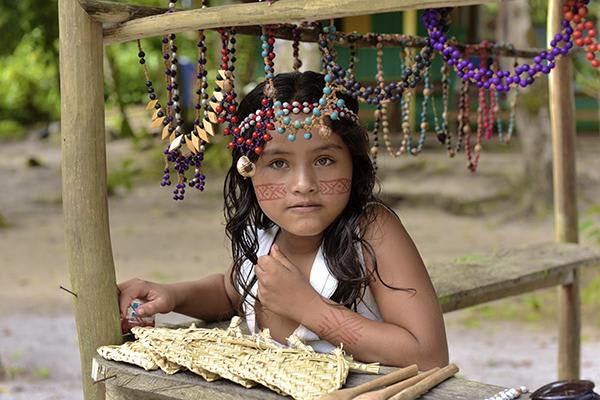
Xixuaú Reserve
AM - PM: After breakfast, we visit the village of Xixuaú to get to know the area and its inhabitants. We then take to the water, in small canoes, paddled by local guides, to observe the bird and aquatic mammal life in the lakes and river beaches of the area. Among the species, we are likely to see are river otters, dolphins, toucans, and howler monkeys searching for fruit in the flooded forest. Their call is unmistakable!

Xixuaú Reserve
AM: Before breakfast, we go looking for black caiman along the river banks, near Xixuaú village. After breakfast, we begin a jungle expedition that culminates in an optional night camping in the rainforest. We begin by navigating in our expedition canoes through narrow creeks filled with crystalline water. Here we can snorkel to observe the aquatic life.
PM: On arrival at the campsite, our guides give us a short jungle survival course, showing us how to construct a shelter using the resources to be found in the area. The area is great for spotting wildlife, both in daylight and after dark. So, after dinner, we go in search of caiman and other nocturnal animals, using flashlights. We also try our hand at spearfishing, which is an essential local technique for finding food. The rest of the evening can be spent around the campfire, hearing about the legendary creatures of the rainforest before we retire to our hammocks for the night.

Xixuaú, Rio Jauaperi & Rio Negro
AM: For those that camped in the rainforest, the day starts waking up to the sounds of the jungle. Breakfast will be at the camp, before return to Xixuaú village, looking out for wildlife along the way. Once back in Xixuaú, we have a farewell gathering in the village maloca, a traditional Amazon longhouse, before we board the La Jangada again to begin the journey back to Novo Airão.
PM: The rest of the day is spent on board, as we sail back down the Rio Negro: a chance to relax, eat, talk about what we've seen and enjoy the views passing by from the sun deck. We continue sailing through the night.
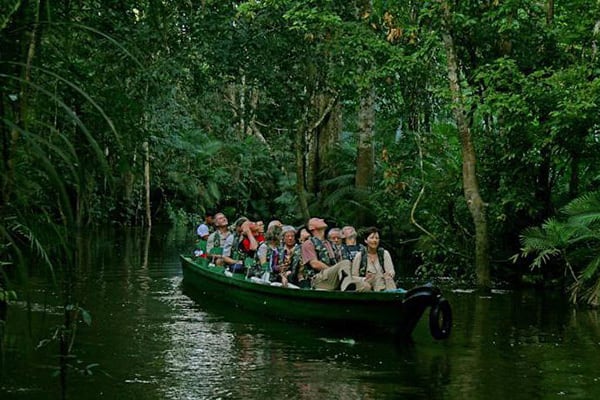
Disembarkation
AM: We should arrive in Novo Airão at around 10:00, where we have time for a city tour to see the ship-building, the craftsmanship, and other attractions of this Amazon River town. Pink river dolphins can regularly be seen in the river near the town.
PM: We have a farewell lunch on board, before taking the van back to Manaus, arriving mid-afternoon.
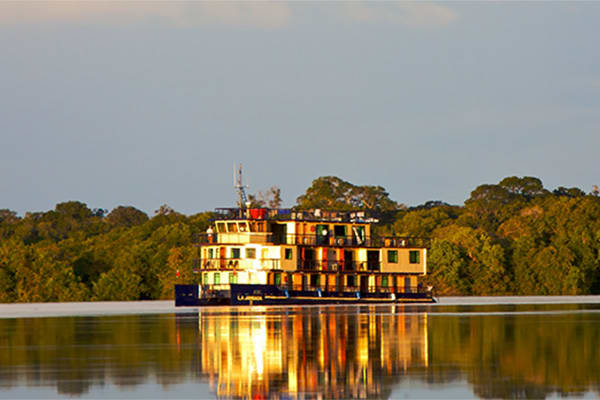
Accommodations
Social Areas
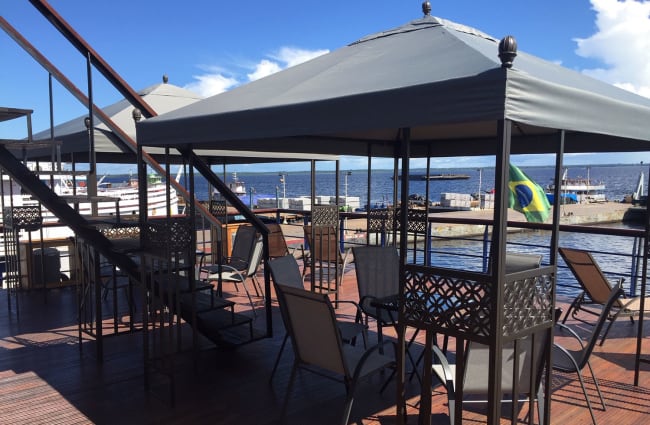
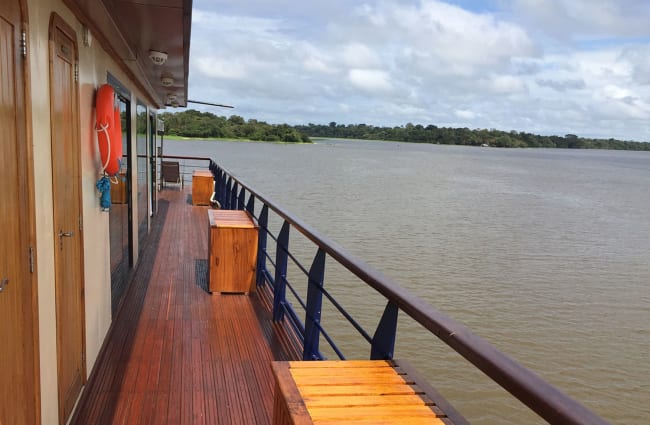
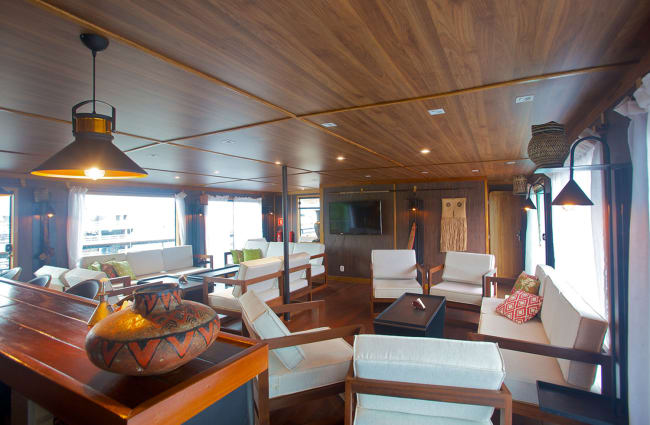
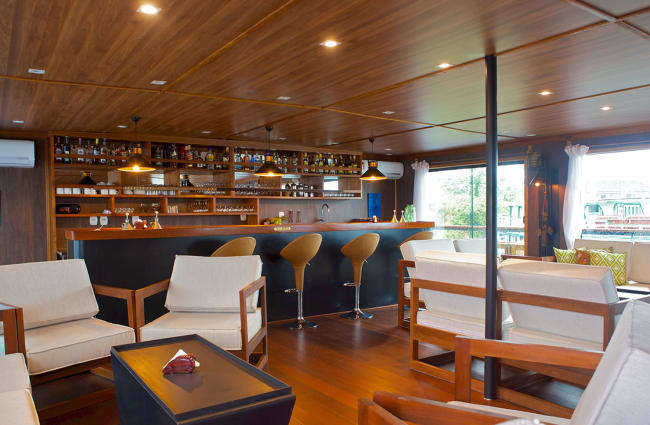

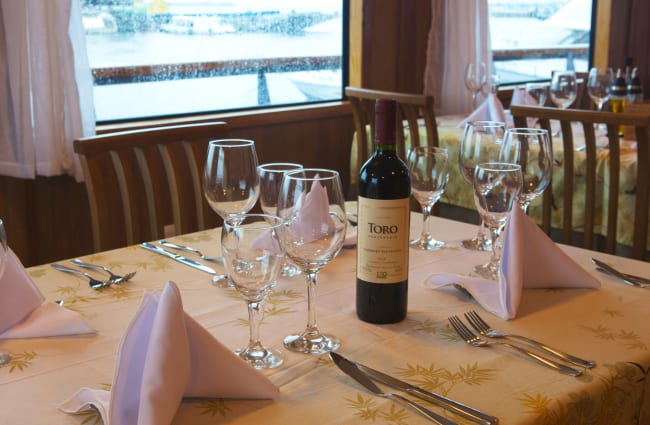
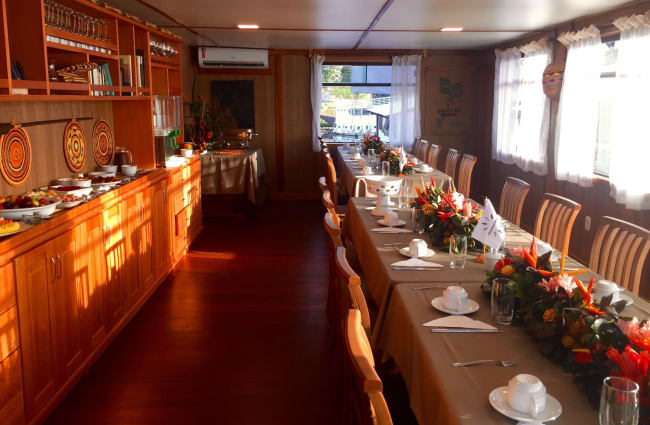
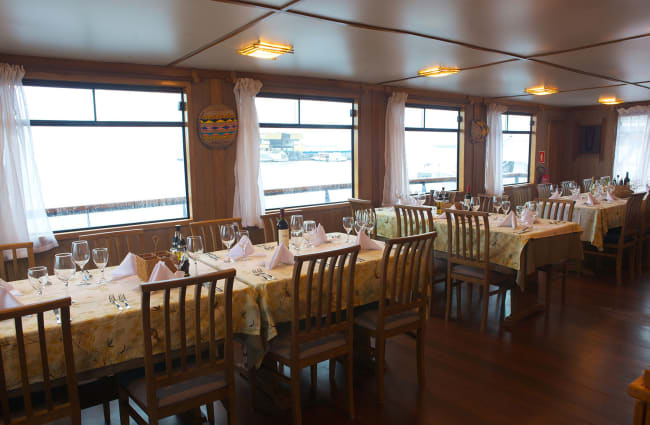

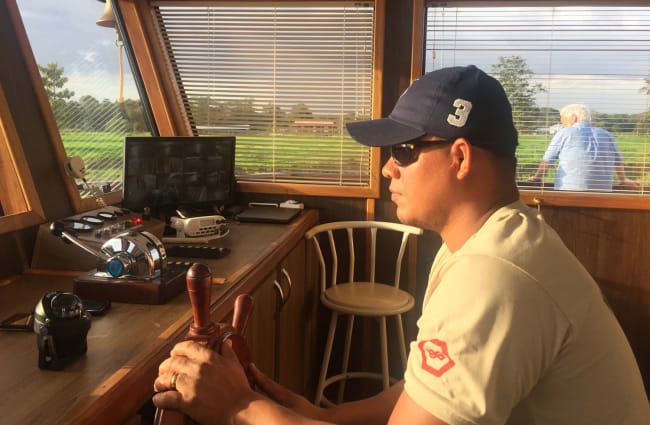
Suites & Cabins

Standard Suites
These air-conditioned Suites feature large windows facing the landscape. The rooms are equipped with a desk, a chair, and a lamp for guests looking to work. These cabins also have en-suite bathrooms with hot water.


Premium Suites
Guests can enjoy the fantastic view of the Amazons from the private terrace. They feature a desk, a chair, and a lamp for guests who want to read. Rooms also feature a sofa bed. The private bathrooms come with hot water.



Superior Suites
These spacious and air-conditioned cabins come with extra-large balconies for guests to relax and enjoy the magnificent scenery of the Amazon. The private ensuite facilities are fully equipped with hot water, a hairdryer to help keep guests refreshed.
Related Cruises

- Amazon
- Brazil
Tucano

- Amazon
- Brazil
Acqua Amazon
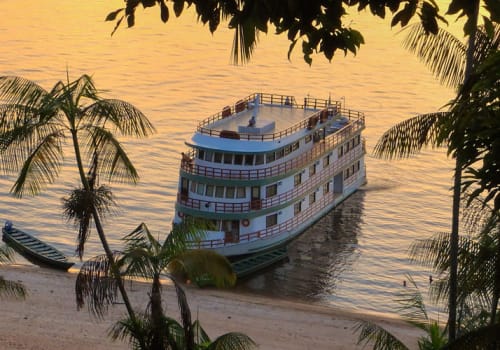
- Amazon
- Brazil
Amazon Clipper Premium
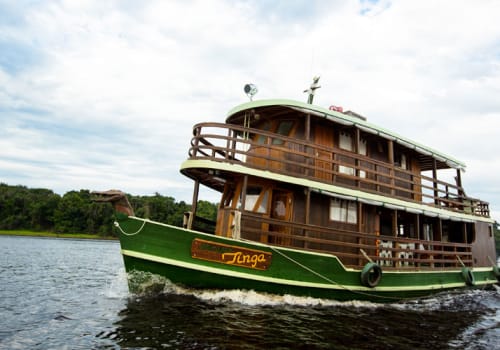
- Amazon
- Brazil
Jacaré-Tinga
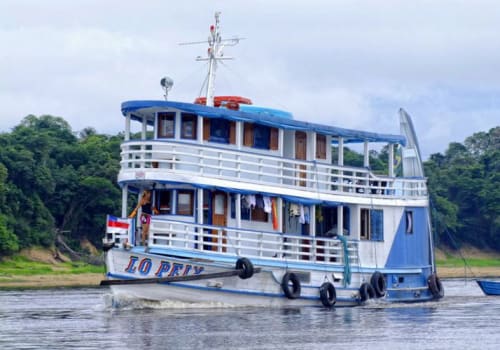
- Amazon
- Brazil
Lo Peix

- Amazon
- Brazil
Amazon EcoBoat

- Amazon
- Brazil
Manakin
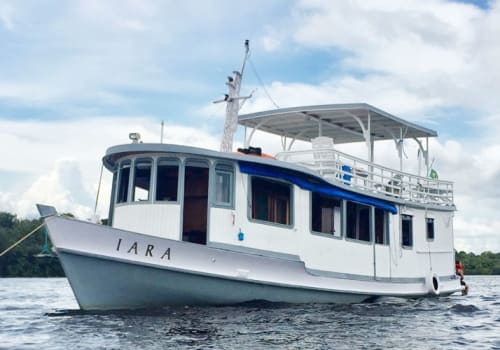
- Amazon
- Brazil
Iara
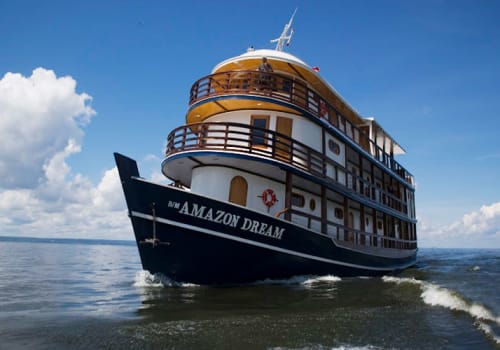
- Amazon
- Brazil
Amazon Dream
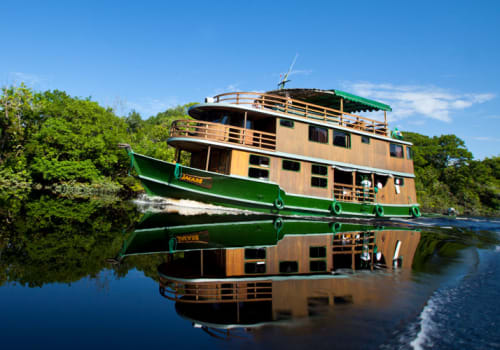
- Amazon
- Brazil
Jacaré-Açu

- Amazon
- Brazil
Iracema
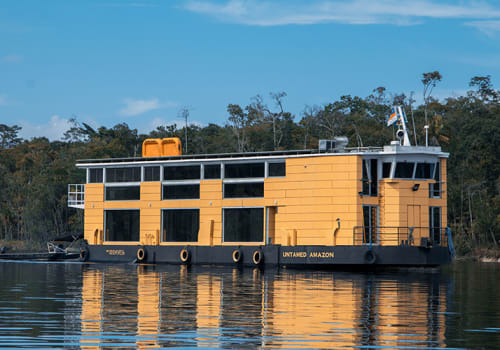
- Amazon
- Brazil

